
Parmer County is a county located in the southwestern Texas Panhandle on the High Plains of the Llano Estacado in the U.S. state of Texas. As of the 2020 Census, the population was 9,869. The county seat is Farwell. The county was created in 1876 and later organized in 1907. It is named in honor of Martin Parmer, a signer of the Texas Declaration of Independence and early judge. Parmer County was one of 10 prohibition, or entirely dry, counties in the state of Texas, but is now a wet county.
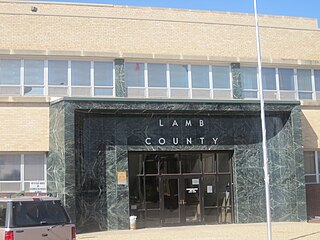
Lamb County is a county located in the U.S. state of Texas. As of the 2020 census, its population was 13,045. Its county seat is Littlefield. The county was created in 1876, but not organized until 1908. It is named for George A. Lamb, who died in the Battle of San Jacinto.

Hockley County is a county located in the U.S. state of Texas. As of the 2020 census, its population was 21,537. Its county seat is Levelland. The county was created in 1876, but not organized until 1921. It is named for George Washington Hockley, a secretary of war of the Republic of Texas.

Cochran County is a county located in the U.S. state of Texas. As of the 2020 census, its population was 2,547. The county seat is Morton. The county was created in 1876 and later organized in 1924. It is named for Robert E. Cochran, a defender of the Alamo.

Briscoe County is a county located in the U.S. state of Texas. As of the 2020 census, the population was 1,435. Its county seat is Silverton. The county was created in 1876 and later organized in 1892. It is named for Andrew Briscoe, a soldier during the Texas Revolution.
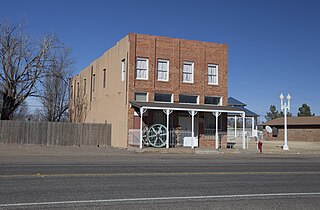
Whiteface is a town in Cochran County, Texas, United States. The population was 449 at the 2010 census.
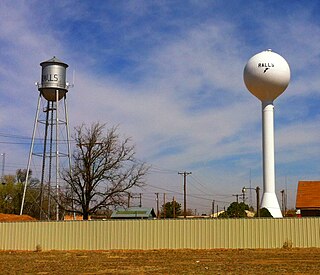
Ralls is a city in Crosby County, Texas, United States. It was named after John Robinson Ralls, who, with the help of W.E. McLaughlin, laid out the townsite in July 1911. As of the 2020 census, it had a population of 1,665, down from 1,944 at the 2010 census. Ralls is surrounded by productive farmlands that primarily produce cotton and grains, with lesser amounts of soybean, sunflower seed, and vegetables.
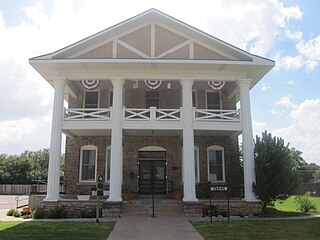
Post is a city in and the county seat of Garza County, Texas, United States. Its population was 4,790 at the 2020 census, and according to 2023 census estimates, the city is estimated to have a population of 3,486. The Triassic reptile Postosuchus is named after the city.

Hale Center is a city in Hale County, Texas. The population was 2,062 at the 2020 census, down from 2,252 in 2010.

Petersburg is a city in Hale County, Texas, United States. As of the 2020 census, it had a population of 1,014.

Anton is a city in Hockley County, Texas, United States. The population was 907 at the 2020 census.
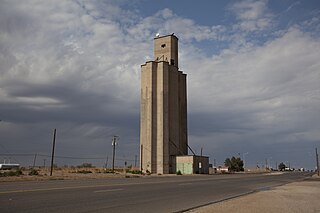
Ropesville is a city in Hockley County, Texas, United States. Its population was 430 at the 2020 census, down from 434 at the 2010 census.
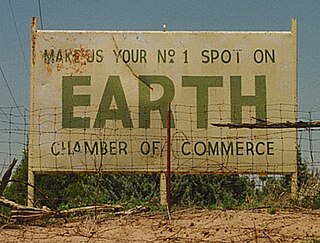
Earth is a small, rural city in Lamb County, West Texas, United States. As of 2022, the population was 999.

Olton is a city in Lamb County, Texas, United States. The population was 1,989 at the 2020 census.
New Deal is a town in Lubbock County, Texas, United States. The population was 730 at the 2020 census. It is part of the Lubbock Metropolitan Statistical Area and the Llano Estacado region.

Shallowater is a city in Lubbock County, Texas, United States. Shallowater is on U.S. Route 84 and the Burlington Northern Santa Fe line, 12 miles (19 km) northwest of Lubbock. Its population was 2,964 at the 2020 census. It is part of the Lubbock metropolitan statistical area.

Slaton is a city in Lubbock County, Texas, United States. Founded by German immigrants, Slaton was the westernmost German settlement in Texas. The population was 5,858 at the 2020 census. Slaton is part of the Lubbock Metropolitan Statistical Area.
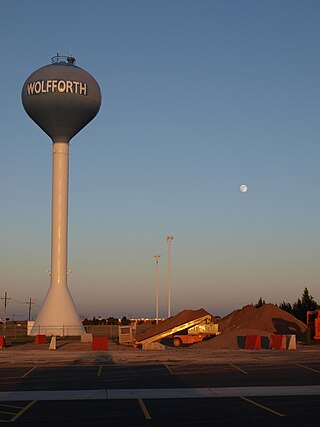
Wolfforth is a town located in Lubbock County, Texas, United States. It is a southwestern suburb of Lubbock. The population was 5,521 at the 2020 census.

Bovina is a city in Parmer County, Texas, United States. The population was 1,868 at the 2010 census.

O'Donnell is a West Texas city that lies primarily in Lynn County, with a small portion extending south into Dawson County, Texas, United States. Its population was 704 at the 2020 census. The Lynn county portion of O'Donnell is part of the Lubbock Metropolitan area.






















